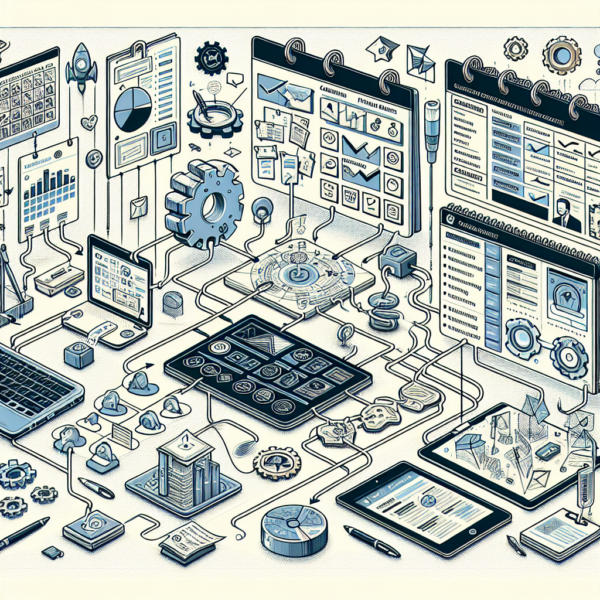In the dynamic world of project management, there is a constant need to simplify and streamline tasks. Therefore, project management involves juggling various elements such as resources, schedules, tasks, and progress. Effectively communicating these elements within the team and to the stakeholders is a crucial role of the project manager. One technique that is gaining prominence in fulfilling this role effectively is the use of icons in project management.
Icons provide an easy and efficient method for communication. In project management, they serve a vital role by making information easy to comprehend and digest. With icons, complex data and multi-step tasks are simplified into small, understandable visuals, offering a quick overview of the project status, tasks, or instructions. This reduces information overload and enhances comprehension amongst team members. Moreover, the simplicity of icons fosters an engaging and user-friendly environment, motivating team members and stakeholders to get involved in the project.
This blog post aims to delve deep into the world of icons, particularly focusing on their usage in project management. We will not only decode commonly used icons but also look at their role through various stages of project management, from planning to project closing. Additionally, we will explore project management tools that integrate icons, supported by a case study of a successful project. Finally, we will provide guidance on the creation and maintenance of custom icons for your project. By the end of this post, you will have a clear understanding of how the use of icons in project management works to simplify and enhance project processes.
Decoding the Icons in Project Management
In project management, icons serve a specific purpose. They are not just decorative elements. These small pictorial illustrations offer a simplified way to represent actions, tasks, and tools within a project. By intuitively depicting different stages, roles, or components of the project, they help navigate through the project’s complexities. Icons eliminate the need for excessive text, making the management process more efficient and comprehensible. Furthermore, apart from streamlining communication, they enable quick recognition and understanding, especially crucial in large projects where team members are across various regions and time zones.
Moving on to some of the commonly used icons, let’s explore what they represent. Any project management tool you work with will include icons such as a pencil for editing, a bin for deleting, a magnifying glass for searching, and a checkmark for completing a task. Additionally, there are specific icons for project management. For example, people or avatar icons represent team members while a clock icon can signify deadlines. Similarly, a file or folder icon represents project deliverables, and chart icons are for visualizing progress or results. Understanding these common icons can significantly enhance your project management efficiency.
Icons bring several benefits to the table in project management. They provide a visual roadmap for your project plan, making it easily digestible at a glance. This visual information display aids in quicker decision-making, saving valuable time. Moreover, icons improve usability by simplifying complex tasks, helping team members understand their roles and responsibilities quickly. For instance, a risky task can be represented with a danger or warning icon, alerting team members to potential challenges. Overall, using icons in project management improves workflow, enhances communication, and fosters a better understanding of the project’s nuances among team members.
Effective Use of Icons in Different stages of Project Management
Icons can be exceptionally useful in the various stages of project management, assisting in clarity and streamlining processes. Let’s delve into the use of the icon for project management in the planning stage first. Icons may be used here to represent key elements of the project like tasks, resources, timelines, and even objectives. Whether it’s the presence of a clock icon to indicate time-bound tasks, or a pie-chart to denote statistical analysis, icons aid in better comprehension and quicker assimilation of information in planning.
The next stage, scheduling, also finds the icon for project management truly handy. In this phase, icons can be used to visually separate different tasks, mark project milestones, or denote deadlines. For instance, calendar icons can be used to delineate timelines, or a flag icon to denote a significant project milestone. Such visual representations significantly improve understanding and coordination among team members, increasing overall efficiency.
Moving to the monitoring and tracking phases, icons become even more critical. Here, they act as visual indicators of the progress and status of tasks. A tick mark can indicate a completed task while a cross could indicate an issue or a stalled task. Different color codes can be further used to indicate the severity or priority of tasks, making tracking easier and more intuitive.
Finally, in the project closing stage, pictographic representations like a checkmark or a closed lock icon may be used to denote the completion of the project or individual tasks. They help in giving a clear picture of the project at a glance and indicate areas where resources have been freed up and can be utilized elsewhere.
Across different stages of project management, the use of icons offers enhanced understanding, streamlined communication, and improved efficiency. When used effectively, it can significantly enhance the process of project management and lead to better outcomes.
Tools and Applications with integrated Icons in project management
To fully leverage the power of icons for project management, it’s crucial to employ tools and applications that integrate these symbols into their interface. Many project management tools today understand the significance of visual symbols and have intertwined them within their ecosystem. These tools utilize icons for various functionalities, whether it’s for designating task priorities, indicating different stages of projects, illustrating the progress of tasks, or differentiating between different modules. A well-designed task management tool with intuitive icons can drastically streamline your workflow and improve your project management efficiency.
A multitude of benefits can result from using these project management tools with integrated icons. First, the visual nature of icons can help decipher the status, priority, and nature of tasks effortlessly, thereby saving valuable time. Furthermore, symbols provide a universal language, making communication and comprehension more straightforward, especially in multicultural teams. Icons also foster quicker processing of information compared to text and can assist in eliminating oversized text blocks. Lastly, icon-based tools are great for visual learners, as they provide vivid and pictorial information, making it easier to remember and understand project details.
Let’s delve into a case study to understand the practical application and effectiveness of an icon-based project management tool. The XYZ Corporation, a multinational conglomerate, was juggling multiple projects with teams spread globally. Text-based project management was ineffective and burdensome, leading to miscommunication and confusion. To streamline their process, they switched to an icon-integrated project management tool. Within a few weeks, they noted a remarkable increase in productivity, reduced miscommunications, and an overall improvement in their project management process. This example demonstrates how icon-based tools can deliver significant improvements in project management.
Incorporating icon-integrated tools offers an innovative way to streamline project management, clearly communicating tasks and progress, and setting a clear path toward project success. Using them effectively can significantly aid in the better management of projects, teams, and resources. They can be viable catalysts in improving communication, facilitating understanding, and driving project efficiency.
Designing Custom Icons for Your Project Management
While tools are abundantly available to provide a suite of ready-to-use icons, you may at times find the need to design custom icons for your project management due to specific requirements, unique projects, or simply to enhance brand identification. Unique icons can add an individual twist to your project, making it stand out to team members and stakeholders. Custom icons must accurately represent the tasks they are assigned to and should be easily recognizable, thus contributing to an efficient project management workflow.
Designing meaningful and effective icons can seem like a daunting task, however, keeping a few principles in mind can help. First, maintain simplicity in your design. The icon is a symbol, not a story – it must convey its purpose in the simplest way possible. Second, it should be consistent with the design language of other icons in your set. And finally, it must be relevant and intuitive. It needs to convey its purpose without the need for any textual explanation. Continue testing your icon with users and refine it based on feedback.
Just as vocabulary consistency is crucial in language, similarly, design consistency is vital in iconography used across different projects in project management. Consistency brings harmony and cohesion to your project, reducing cognitive load on team members as they don’t have to learn new symbols for every project. However, consistency does not necessarily mean using the exact same icons. It involves maintaining the same design styles, shapes, proportions, and color palettes. By ensuring consistency in their design, icons can make your project self-explanatory and inspire confidence among team members and stakeholders.
Therefore, designing custom icons for your project management can be a tactical approach to manage unique projects or enhance the brand. A well-thought-out design process can help create meaningful and effective icons, while maintaining consistency in design across projects can ensure their effective usage.
Conclusion
We’ve now come to the end of our exploration of ‘Project Management Simplified: Understanding Icons and Their Uses.’ In our discussion, we revisited the fundamental concept of project management, delving into the integral role that icons play in facilitating this process. Whether it’s about streamlining communication, improving visualization, or enhancing overall efficiency, it’s clear that the icon for project management serves an essential purpose.
One of the key takeaways from our discourse is the importance of recognizing and understanding the most commonly used icons in project management. This recognition will not only allow you to utilize these pre-made icons effectively but will also facilitate your communication with team members, stakeholders, and clients. It’s undeniable that the use of icons makes the project management process more intuitive and user-friendly.
Icons for project management become particularly beneficial when used effectively at various stages of project management, including planning, scheduling, tracking, monitoring, and closing projects. As we’ve seen, they can visually represent complex data, stages, tasks, and dates, and provide a synchronizing point for the entire team, thus making the workflow more coherent and easy to navigate.
Also, remember, there are numerous project management tools available that incorporate the use of icons. Using these tools can significantly simplify the project management process and ensure your team is on the same page. Our case study demonstrated how the effective use of an icon-based project management tool can result in a successful project outcome.
Finally, we also discussed the possibilities and benefits of creating your own customized icons for project management. This might be necessary when you’re dealing with unique projects that might not fit perfectly into the traditional mold. The key is to keep the designs meaningful and consistent across all projects to maintain standardization.
To sum up, integrating icons into your project management workflow can greatly improve your process and navigation. We hope that this blog post has helped you better understand the icon for project management and has encouraged you to embrace these graphical representations for an efficient workflow. In the vastly complex world of project management, these simple yet effective symbols can truly be a game-changer. Take the step to decode and use icons to enhance your project management technique for better, quicker, and more efficient results.


